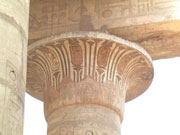ANCIENT SUDAN:
KINGDOM OF THE BLACK PHARAOHS
KINGDOM OF THE BLACK PHARAOHS

The Pyramids of Meroe
"Your kingdoms have been stripped away from you.
The rivers of your tribute have been dammed.
The great emperors that favoured you now lie
Deep buried in the dune of centuries.
The hands that shaped your stony horns are gone.
But you are Ram, sculpted, more immortal;
Born-again by archaeology's spade,
You're once, twice and thrice the cynosure.
Your horns are whorled. Your pedestal survives,
Grained with the stain of old oblation's blood.
Your eyes are blank. Your beatless heart is cold.
Your tongue is muter than your craftsman's muse.
You're the stone ram - the silent oracle
Who is forever therefore, never wrong".
The rivers of your tribute have been dammed.
The great emperors that favoured you now lie
Deep buried in the dune of centuries.
The hands that shaped your stony horns are gone.
But you are Ram, sculpted, more immortal;
Born-again by archaeology's spade,
You're once, twice and thrice the cynosure.
Your horns are whorled. Your pedestal survives,
Grained with the stain of old oblation's blood.
Your eyes are blank. Your beatless heart is cold.
Your tongue is muter than your craftsman's muse.
You're the stone ram - the silent oracle
Who is forever therefore, never wrong".
Chuma Nwokolo, from the Poem �Ram�
inspired by the ram of Taharqa in the Ashmolean Museum
inspired by the ram of Taharqa in the Ashmolean Museum
THE TOUR
This two week tour of the Sudan explores the ancient history of the region between Khartoum and the Egyptian border. These remains stem from the native Nubian culture of Kerma, the invading Egyptians of the New Kingdom, and the �Black Pharaohs� of Napata and Meroe.
The tour begins in Khartoum where we visit the Ethnographical Museum and see the wonderful collection of artefacts in the Khartoum National Archaeological Museum. This includes the remains of 4 temples which were moved to Khartoum when the Aswan Dam was built in the 1960s. We also go for a cruise on the Nile to see the confluence of the Blue and White Niles.
We then cross the open desert by 4-wheel drive to Old Dongola where we see the ruins of this ancient Christian city from the 10th Century AD. We camp for one night in the sand dunes nearby. We then head north, visiting a local Nubian village and explore the ruins of ancient Kerma, which was inhabited from 2500 - 1500 BC. The cemetery and town remains provide a fascinating insight into ancient culture of the region. The local Museum contains a superb collection of artefacts discovered at Kerma over the past century including a recently discovered cache of statues.
Next we explore the granite region of Tombos and see unfinished statues and a number of ancient Egyptian inscriptions. We camp for a night amongst the granite boulders. Further north the Third Cataract is a stunning sight, the Nile River blocked by numerous granite islands. We cross the Nile by ferry and then head north to visit the ancient Egyptian town and temple sites at Sesebi, Soleb and Sedeinga. These monuments date from the reigns of Amenhotep III and Akhenaten from the Egyptian 18th Dynasty (14th Century BC). Soleb Temple preserves numerous scenes and texts of this high point of Egyptian culture.
Our program then takes us south to the town of Karima which will be our base for a few days exploration of the local antiquities. Our accommodation is the very pleasant �Nubian Resthouse� in Karima, an island of luxury in the desert. We visit the site of Jebel Barkal, where the Kings of the 25th Dynasty built temples to the Egyptian gods Amun-Re and Mut. We explore the local antiquities Museum and visit the ancient cemetery of el Kurru where the Kings were buried under pyramids in painted underground chambers. Two tombs, belonging to King Tanutamani and his mother Qalhata, are open. We also see an area of the open desert with evidence of fossilised wood.
In Karima we explore the local markets and take a cruise on the Nile to visit the granite boulders of the 4th Cataract. This gives us a chance to visit one of the islands and see something of the lifestyle of the local people. We also see the grand site of Nuri. Here 20 Kings and more than 50 Queens were buried under pyramids during the Napatan period from the 7th - 3rd Centuries BC.
We then head south across the Bayuda Desert, stopping en route to see the remains of the Ghazoli Monastery. The desert is stark and beautiful with local villages located near isolated wells. In the afternoon we reach the famous cemetery of Meroe with its 40 pyramids (3rd Century BC to 4th Century AD). Each pyramid has a small mortuary temple on its east face, decorated with elaborate scenes and hieroglyphic texts. We check into the Meroe Tented camp, our base for the next few days.
We now explore the Meroitic remains in the local region. This includes the remains of the ancient city of Meroe, including the Temple of Amun. To the south are the well preserved ruins of Naga, with its Temple to the Lion God Apedemek and the impressive Temple of Amun with its avenue of sphinxes. Nearby the remains of Musawwarat Es-Sufra include the impressive �Great Enclosure� and a Temple of Apedemek.
Our tour concludes with our return to Khartoum. En route we stop to see the granite rocks of the 6th Cataract and visit the 19th Century capital city of Omdurman. Here we see the Tomb of the Mahdi and the small Museum dedicated to the period of Gordon and Kitchener. Last minute shopping for Sudanese gifts can be done in the Omdurman markets.
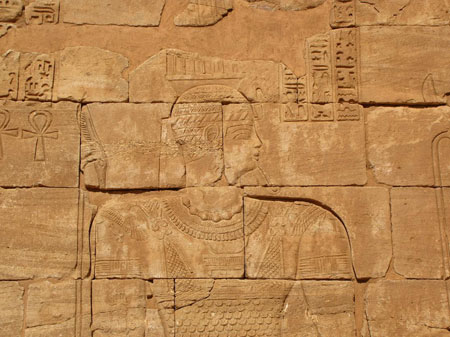
King Erkamanis from Wusawwarat Es-Sufra
ITINERARY*
Day 1: Leave Australia
Our flight on Etihad leaves from either Sydney or Melbourne. We stop for a few hours at Abu Dhabi for our connecting flight to Khartoum.
Day 2: Arrive in Khartoum
We arrive in Khartoum airport in the early afternoon. We are met by our local guide, and transferred to our hotel. We check in and then go for a short walk along the Nile, making a visit to Tuti Island at the confluence of the Blue and White Niles. There is a buffet dinner in the hotel (at own expense).
Day 3: Ethnographic Museum - Archaeological Museum - Nile Cruise
In the morning we take a short drive through the centre of Khartoum to the Ethnographic Museum. We explore the interesting collection of artefacts reflecting the different ethnic groups in the country. We then visit the National Archaeological Museum. This collection includes numerous objects reflecting the history of the Sudan as well as 4 temples rescued by UNESCO and moved from the Lake Nasser area after the construction of the Aswan Dam. Lunch is in a restaurant by the Nile. In the afternoon we take a motorboat trip to the confluence of Blue and White Nile. Dinner is in a Khartoum restaurant at own expense.
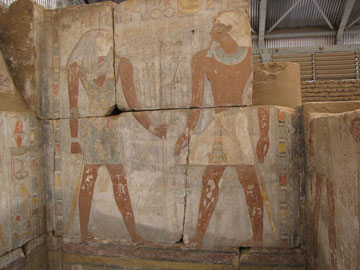 |
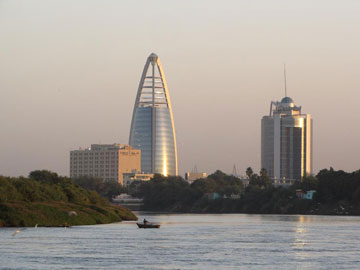 |
The Temple of Buhen now in Khartoum Museum |
The confluence of Blue and White Niles at Khartoum |
Day 4: Desert crossing - Old Dongola
Today we leave Khartoum, and head NW across the open desert. The landscape consists of open fields with low scrub. We cross the Nile by bridge and then head to the site of Old Dongola where we visit the archaeological site. Capital of a mediaeval Christian Kingdom, Dongola preserves remains of the ancient throne hall, several churches and the bee-hive tombs of the mediaeval Islamic Period. We camp amongst the sand dunes.
Day 5: Nubian Village - Kerma - Kerma Museum - Tombos
Today we continue northward, visiting a Nubian village with traditional painted walls. This area is in the central part of the Nubian region. Here the population speaks a different language from the Arabs, and also the Islamic religion is not as �strict� as in other regions. We head to the ancient site of Kerma with its monumental tombs of the Middle Bronze Age and impressive mudbrick temple known as the �Western Defuffa�. The onsite Museum constrains a superb collection of artefacts from the area including a cache of royal statues. In the afternoon we reach the area of Tombos where we set up our camp.
Day 6: Tombos - Sebu - 3rd Cataract - Sesibi - Soleb
After breakfast we explore the rocks near the village of Tombos, where there are granite quarries and the remains of a huge statue of a Napatan King, abandoned in the desert for 3000 years ago. In Sebu, we visit one of the richest sites of rock engraving in the Sudan, with hundreds of images from prehistoric to Egyptian times. We then reach the granite boulders of the Third Cataract with a superb view over the Nile from the Turkish fortress. We cross the Nile by local ferry. After driving north on the western side of the river, we reach the ancient Egyptian townsite of Sesibi. We visit the archaeological site and in the evening arrive in Soleb where we stay in a local house compound.
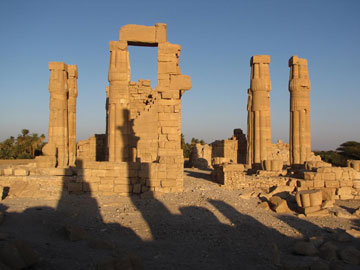 |
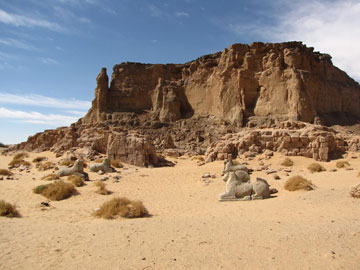 |
The Temple of Soleb at Sunset - magical! |
The Temple of Amun at Jebel Barkal |
Day 7: Soleb - Sedeinga - Soleb
In the morning we visit the Temple of Soleb which is an impressive ancient Egyptian temple in the Sudan. Constructed by Amenhotep III, it is a testimony to the New Kingdom in Nubia. The walls are richly inscribed with hieroglyphic inscriptions and bas-relief figures of Amenhotep III and his son Akhenaten. After lunch we head northward to visit the New Kingdom Temple of Sedeinga, built by Amenhotep III for his wife Queen Tiye. We return to Soleb and our accommodation.
Day 8: Selim - the open desert - Karima - Pyramids of Jebel Barkal
After breakfast we begin our journey southward. We drive back to the ferry crossing point. We stop for a short visit to the colourful market of Selim. We then head south, crossing the open desert to the town of Karima. Upon arrival we explore the Pyramids of Jebel Barkal, tombs of Napatan and Meroitic Kings of 3rd-1st Century BC. We check into our accommodation in Karima, called the Nubian Resthouse.
Day 9: Karima - Jebel Barkal - El Kurru - petrified forest
We explore the antiquities of Jebel Barkal, an isolated red sandstone mountain, considered holy since ancient times. We start with the local Museum which contains artefacts found nearby. We then explore the Temple of Amun, founded in the 18th Dynasty and greatly expanded by the Napatan Kings from the 7th to 4th Century BC. We also see the Temple of Mut, a rockcut shrine built by King Taharka, which preserves high quality painted relief decoration. After lunch we travel to the village of El Kurru, location of one of the necropolises of ancient Napata. Here we visit two royal tombs, excavated in the rock under stone pyramids, which preserve superb painted images of the Pharaoh Tanutamani and his mother Qalhata. The excursion continues with a visit to an area in the desert which preserves evidence of fossil tree trunks.
Day 10: Free day
This day is set aside to rest and relax. There are numerous opportunities to re-explore the local antiquities at Jebel Barkal. The top of the mountain is an easy ascent and provides a spectacular view over the local landscape.
Day 11: Karima - Nile cruise to the 4th Cataract - Necropolis of Nuri
After breakfast, we visit the market in Karima, where we can enjoy an authentic experience of meeting the friendly Sudanese people. We then take a short cruise on the Nile to explore the granite rocky formations of the 4th Cataract, an area rich in birdlife. We take a walk on one of the small islands to explore a local village. We take a picnic lunch in the palm gardens before heading to Nuri. Here we explore the pyramids of 20 Napatan Kings including that of King Taharka.
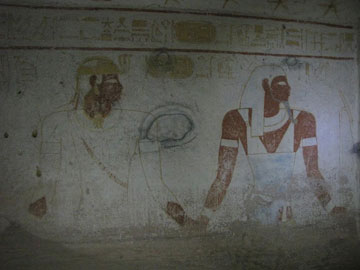 |
 |
The painted burial chamber of Tanutamani at El Kurru |
The pyramids at Nuri - majestic! |
Day 12: Ghazoli Monastery ruins - Bayuda desert crossing - Meroe
We cross the Nile and make a brief visit to the ruins of the mediaeval Ghazoli Monastery. We then enter the Bayuda Desert, an area bounded by the loop formed by the Nile between the 4th and the 6th Cataracts. It is characterised by black basalt mountains, alternating with level pebble stretches and large dry wadis. We may meet an isolated camel and donkey caravan of the Bisharin nomads. After lunch we cross the Nile near Atbara and proceed southward to Meroe. Here we arrive around sunset to see the stunning sight of 40 pyramids spread out over two low ridges. We check in to our new accommodation at the Meroe permanent tented camp.
Day 13: Meroe - Necropolis - sandstone quarries - Royal City of Meroe
We visit the Royal Necropolis of Meroe located about 3km from the Nile on two hills covered with yellow sand dunes. We explore the site including the small mortuary temples decorated with bas-reliefs depicting the Kings and Queens in association with funerary deities. We then visit the quarries where the stone was cut for the pyramid construction. After lunch we visit the remains of the Royal City of Meroe where we see the ruins of the Temple of Amun and the so-called �Royal Baths�.
Day 14: The Temples of Naga - Musawwarat es-Sufra
After breakfast we head south to Naga, an important religious site during the Meroitic period (3rd Century BC to 4th Century AD). At Naga, we explore the bas-relief decorations of the Temple of the Lion God Apedemek (1st century AD). Nearby there is a small kiosk or bark shrine combining elements of Egyptian, Roman and the Greek architecture. After a picnic lunch we visit the Temple of Amun which contains an impressive avenue of rams and beautiful bas-reliefs. We then drive north to Musawwarat es-Sufra, a settlement located in a valley crowned by hills. The ruins include a very large compound known as �the Great Enclosure�, and a temple dedicated to Apedemek. In the afternoon we return to the camp at Meroe.
 |
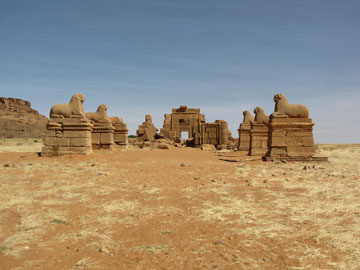 |
The pyramids of Meroe |
The Amun Temple at Naga |
Day 15: Meroe to Khartoum - 6th Cataract - Omdurman - Khartoum
We head south through the Western desert, an area covered with huge granite boulders. A detour from the asphalt road leads us to the 6th Cataract of the Nile where these formations are even more impressive. In the afternoon we reach Omdurman, capital of the Sudan in the late 19th Century. We visit the house of the Khalifa that has been transformed into a museum, and see the mausoleum of the Mahdi from outside. We then visit the bazaar of Omdurman where it is possible to buy some typical local handicrafts. We check in to our Khartoum hotel. Dinner in Khartoum at own expense.
Day 16: Free morning - departure from Khartoum
We have some free time in the morning to take a walk in downtown Khartoum. We depart from Khartoum on Etihad Airways.
Day 17: Arrive Australia.
We arrive back in Australia.
* Please note that the Company reserves the right to make alterations to the itinerary in the period up to 60 days prior to a tour departure. The itinerary may also be subject to minor re-arrangement due to the scheduling of the operators and availability of access. If this occurs, the Company will endeavour to provide a comparable alternative.
